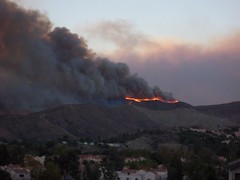Several days ago, I received a voice mail from a newspaper reporter who wanted to talk about social networking. I was working a conference at the time, and with sessions, meetings, and evening banquets, I was not able to return his call until I reached the airport, two days later. His name was Gary Warth, and he was a reporter for the North County Times, serving San Diego.
 Something was happening with the paper’s web site. On Sunday, they’d hosted 175,235 visits. But the next day, it climbed to 878,351 and on Tuesday it peeked at 1,054,354. Of course the San Diego wildfires explained the interest (3.2 million visits for the week) and the increased commenting (19,010). But what struck the staff of the newspaper was the dramatic shift in tone. They were accustomed to comments and sudden spikes in their volume. But these online conversations were typically “contentious as readers bicker about politics, immigration and other divisive issues.“
Something was happening with the paper’s web site. On Sunday, they’d hosted 175,235 visits. But the next day, it climbed to 878,351 and on Tuesday it peeked at 1,054,354. Of course the San Diego wildfires explained the interest (3.2 million visits for the week) and the increased commenting (19,010). But what struck the staff of the newspaper was the dramatic shift in tone. They were accustomed to comments and sudden spikes in their volume. But these online conversations were typically “contentious as readers bicker about politics, immigration and other divisive issues.“
As Warth reported in Online community comes to the fore during fires (27 Oct 2007)…
Readers asked one another for information about their towns or even their specific streets, and other readers directed them to maps or shared whatever they knew.
“Does anyone know how Green Canyon is doing?” wrote reader High Hopes.
Thirty minutes later, High Hopes had an answer from reader MKE: “Green Canyon from Reche to Winterhaven was OK. I think south to Mission is OK. Was at The VFW last night very smoky. No sizable winds at present along Green Canyon.”
A different kind of news service seems to have emerged out of the papers interactive online site. It was a service that tapped into the community for reporters and on-demand stories as the communication shifted from broadcast delivery to multicast conversation.
Warth mentioned, during our brief phone conversation, a couple of other experts he’d talked with. After reading the story, I learned that one of them was Bernie Dodge (San Diego State University professor and inventor of the Webquest), who’d been relying on Twitter to keep track of friends in the San Diego area. Another was Andy Carvin, who’s been a student of this phenomena since the Kobe earthquake in 1995.
The North County Times, as a traditional news service, provides information within an environment of information scarcity. They sell news content. What emerged during the wild fires, and was facilitated by the paper’s online presence, was a different kind of news service that was based on information demand and information abundance — and that information was free. It’s a good long tail story.
..and it makes me wonder how we might provoke such information abundant, demand-oriented learning experience in our classrooms. Are they happening already outside our classrooms? How do we tap in?
It will take more than just the technology. And it should take less than a wildfire.
Image Citation:
“Canyon Country Fire 10-21-07.” DisneyKrayzie’s Photostream. 22 Oct 2007. 29 Oct 2007 <http://flickr.com/photos/disneykrayzie/1693225848/>.

Hi David,
They’ve moved the story to here:
http://www.nctimes.com/articles/2007/10/29/lifeandtimes/12_30_7010_27_07.txt
Nice talking to a reporter who’s smart for once.
This is a very interesting article and I like your take on it: “less than a wildfire”.
I was thinking about the newspaper’s interest in traffic surrounding their commenting system. Are they pissed that regular Joes are writing the news? No way! They’re thrilled. The website is a money maker for the North County Times — the advertising can be sold for more if there are more page views.
Of course, news about news is as meta as you can get. It makes me chuckle that a reporter is writing about his own paper’s website.
But what about our classrooms? I’ve pointed the Times article out to a Language Arts teacher at my school. I sent it along to her because her students were showing her the satellite photos of the wildfires last week. The students are already interested…I would love to see every student at my school get a lesson in journalism — and good journalistic writing — from the Times article. A few years ago, only journalists needed to know how to write the news. Not so anymore.
Back in the day, regular folks didn’t need to know about typography and page design. Now that we all produce Word documents by the dozens, we all could use a lesson or two in design. Ditto for journalism.
Thanks for sharing